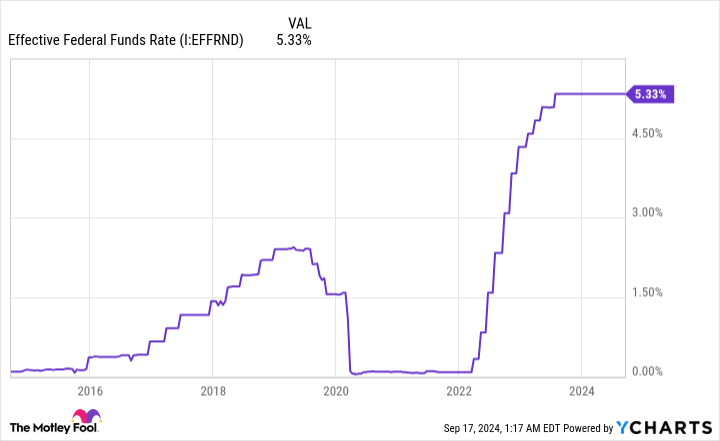One of the best aspects of putting your money to work on Wall Street is there’s no one-size-fits-all investment approach. With thousands of publicly traded companies and exchange-traded funds (ETFs) to choose from, there’s bound to be one or more securities that can help you reach your goal(s).
But among the countless ways to build wealth on Wall Street, few strategies have proved more consistently successful than buying and holding high-quality dividend stocks.
The lure of dividend stocks is simple: they’re almost always recurringly profitable and time-tested. A company that regularly shares a percentage of its profit is one that investors rarely have to worry about when going to sleep at night.

More importantly, dividend stocks have absolutely crushed non-payers in the return column over the last 50 years. A report released last year by the investment advisors at Hartford Funds (The Power of Dividends: Past, Present, and Future) compared the performance of income stocks to non-payers over the last half-century (1973-2023). What Hartford Funds found, in collaboration with Ned Davis Research, is that income stocks more than doubled up the average annual return of non-payers — 9.17% vs. 4.27% — over this span.
But this doesn’t mean investors can throw a dart at the newspaper and pick a winner. All dividend stocks are unique, and ultra-high-yielding companies (those with yields four or more times greater than the S&P 500) often come with added risk. Since yield is a function of share price, a company with a failing business model can “trap” income seekers with a lucrative but unsustainable yield.
But not all supercharged high-yield stocks are worth avoiding. With the Federal Reserve kicking off a rate-easing cycle this week, two income stocks with truly eye-popping yields of 12.5% and 13.9% are perfectly positioned to thrive.
The light at the end of the tunnel has arrived for Wall Street’s most-hated industry
While “most-hated” is a bit of a subjective term, there arguably hasn’t been an industry that analysts have disliked for a longer period than mortgage real estate investment trusts (REITs).
Mortgage REITs are companies that aim to borrow money at lower short-term lending rates and use this capital to purchase higher-yielding long-term assets, such as mortgage-backed securities (MBSs), which is how the industry got its name. The goal for mortgage REITs is to maximize their net interest margin, which is the average yield on the assets they own less their average short-term borrowing costs.
As you probably gathered, the mortgage REIT industry is highly sensitive to changes in interest rates. When the nation’s central bank began its steepest rate-hiking cycle in four decades in March 2022, it sent short-term borrowing costs soaring. The result for the mortgage REIT industry was shrinking net interest margin.
And it’s not just higher interest rates that the industry has to worry about. The velocity of monetary policy moves matters, too. If the Federal Reserve makes slow, calculated, and well-telegraphed moves, mortgage REITs have the opportunity to reposition their assets to maximize returns. But with the Fed chasing a four-decade peak in the prevailing rate of inflation, slow-stepping its rate-hiking cycle quickly went out the door.
Pretty much every publicly traded company in the mortgage REIT industry has seen its book value decline — most mortgage REITs trade very close to their respective book value — and net interest margin shrink since March 2022.
However, the light at the end of the tunnel has finally arrived for Wall Street’s most-hated industry. Annaly Capital Management (NYSE: NLY) and AGNC Investment (NASDAQ: AGNC), which sport respective yields of 12.5% and 13.9%, now have an excellent chance to outperform.


Annaly and AGNC are ideally positioned to thrive during a rate-easing cycle
With the prevailing rate of inflation cooling to 2.5% in August, the lowest reading observed since February 2021, the nation’s central bank was given every incentive in the world to undertake a rate-easing cycle.
When the Fed shifts to a dovish monetary policy and lowers the federal funds rate, it tends to reduce short-term borrowing costs and allows the net interest margin for Annaly and AGNC Investment to expand. At the same time, these two leading mortgage REITs have been able to scoop up MBSs with higher yields over the last two years, which can provide a further lift to their respective net interest margin.
Equally important, the Fed is currently walking on egg shells with regard to monetary policy. After leaving the federal funds rates at historic lows for too long and, in hindsight, overshooting to the upside in the wake of high inflation, the Federal Open Market Committee is liable to slow-step any further changes. Well-telegraphed moves will allow Annaly and AGNC to position to their portfolios for optimal success.
A rate-easing cycle would also be expected to lead to an eventual normalization of the yield curve.
Normally, the Treasury yield curve slopes up and to the right. This is to say that longer-dated bonds set to mature 30 years from now sport higher yields than Treasury bills that will mature in a year or less. We’ve recently witnessed the longest yield-curve inversion in history, with short-term yields handily outpacing long-term bonds. When the yield curve normalizes, mortgage REITs shine.
The final piece of the puzzle for Annaly Capital Management and AGNC Investment is that they predominantly invest in agency securities. An “agency” asset is one that’s backed by the federal government in the unlikely event of default.
Annaly closed out the June-ended quarter with $66 billion of its $74.8 billion portfolio tied up in highly liquid agency assets, while AGNC had all but $1 billion of its $66 billion portfolio allotted to agency MBSs and various agency securities. The added protection Annaly and AGNC enjoy from agency securities allows both companies to prudently lever their portfolios to maximize profits and sustain their outsized dividends.
Although both companies have vastly underperformed in the current bull market, Annaly and AGNC appear ready for their moment in the spotlight.
Should you invest $1,000 in Annaly Capital Management right now?
Before you buy stock in Annaly Capital Management, consider this:
The Motley Fool Stock Advisor analyst team just identified what they believe are the 10 best stocks for investors to buy now… and Annaly Capital Management wasn’t one of them. The 10 stocks that made the cut could produce monster returns in the coming years.
Consider when Nvidia made this list on April 15, 2005… if you invested $1,000 at the time of our recommendation, you’d have $708,348!*
Stock Advisor provides investors with an easy-to-follow blueprint for success, including guidance on building a portfolio, regular updates from analysts, and two new stock picks each month. The Stock Advisor service has more than quadrupled the return of S&P 500 since 2002*.
*Stock Advisor returns as of September 16, 2024
Sean Williams has positions in Annaly Capital Management. The Motley Fool has no position in any of the stocks mentioned. The Motley Fool has a disclosure policy.
2 Ultra-High-Yield Dividend Stocks With 12%-Plus Yields That Are Ideally Positioned for a Rate-Easing Cycle was originally published by The Motley Fool

